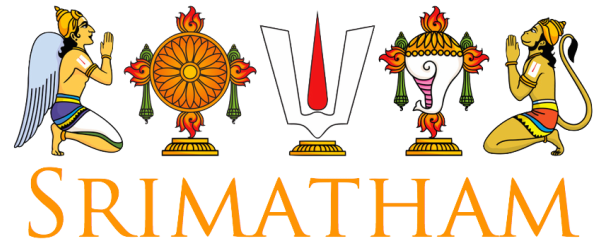Background
Srivaisnavism, is the oldest and the largest vaisnava spiritual tradition. The direct following are found predominantly to the South of India, in the states of Tamilnadu, Andra Pradesh and Karnataka. There are many centres scattered throughout North India. This ancient tradition has maintained its originality and purity, without any philosophical deviations, concoctions or influences of other traditions. On the contrary, its teachings have highly influenced the thoughts of founders of other vaisnava traditions. The main seats of Srivaisnavism are:
- Srirangam (Tamilnadu)
- Tirupati (Andra Pradesh)
- Kancipuram (Tamilnadu)
- Melkote (Karnataka)
- Sri Perumbudur (Tamilnadu)
Srivaisnava Disciplic Succession
According to popular belief, the disciplic succession of the Srivaisnavism, originated from the Supreme Personality of Godhead, Sriman Narayana. He taught them to His eternal consort Laksmi; She in turn revealed them to Visvak-sena the martial entourage of the Lord. He revealed them to Nammalvar (Satakopan), the first of the Alvars.
The Srimad Bhagavatam (Canto XI, chapter 5: verses 38 Q& 39) has predicted that in the beginning of the present age (Kali yuga), many devotees of Lord Vishnu would take birth on the bank of the river Tamraparani in Tamilnadu. They are said to be the 12 Alvars (saints) the pioneers of the devotional movement in India.
The Alvars composed hymns of devotion in the Tamil language, describing their revelations received from the Lord Himself. The Alvars are revered by the Srivaisnavas and their compositions have influenced Srivaisnava theology.
The Srimad Bhagavatam (Canto XI, chapter 5: verses 38 Q& 39) has predicted that in the beginning of the present age (Kali yuga), many devotees of Lord Vishnu would take birth on the bank of the river Tamraparani in Tamilnadu. They are said to be the 12 Alvars (saints) the pioneers of the devotional movement in India.
The Alvars composed hymns of devotion in the Tamil language, describing their revelations received from the Lord Himself. The Alvars are revered by the Srivaisnavas and their compositions have influenced Srivaisnava theology.
Three Great Teachers
Nathamuni
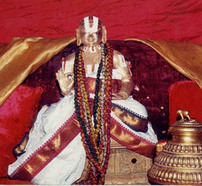
Nathamuni, 9th century Nathamuni believed to have lived during the 9th century was born in the village Vira-narayana in the Chola kingdom. One day, his return to his hometown after a long pilgrimage, Nathamuni met some Srivaisnavas, reciting some 10 hymns composed by Nammalvar. Realising that they were part of a much larger work, he decided to go to the holy temple city, Kumbakonam. The Guru-parampara Prabhavam states, that Madhura-kavi alvar, the disciple of Nammalvar, manifested before Nathamuni and told him that after Nammalvar left his body, the local orthodox community fearing that the study of the Tamil hymns would be detrimental to the Vedic religion, threw them into the river Tamraparani. A page of the hymns, was picked up by a man who appreciated and recited them. Thus only 10 hymns have been saved at this time. Nathamuni recited 12000 times the verse composed by Madhura kavi alvar in adoration of Nammalvar, who then revealed the purport of the entire work to Nathamuni. Not satisfied, Nathamuni wanted to know all the words in detailed. He was asked to approach an artisan, who provided Nathamuni with the complete text of the work, which latter came to be known as Tiruvaymozhi. Nathamuni brought the hymns together and with the help of his two nephews, set them to music in the Vedic manner. From then on, these hymns are sung in the temples and are regarded as Dravida Veda. Nathamuni then pass down the text to his disciple Pundarikaksa, who then gave it to his disciple Rama Misra, Rama Misra gave it to Yamunacarya, who gave it to Gosthipurna, who later instructed Sri Ramanuja on the work.
Yamunacarya
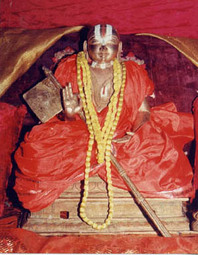
Yamunacarya, (Alavandar), was the son of Isvara Bhatta and the grandson of Nathamuni. He was born in 916 A.D at Viranarayanapuram (Kattu Mannargudi in Tamil Nadu). He mastered several branches of learning in a very w time, under the guidance of Maha Bhasya Bhatta. It is said that he defeated a conceited royal court scholar. In recognition of this victory, he was given the title Alavandar and was granted a gift of a territory by the Pandya king.
It was due to the tireless efforts of Sri Rama Misra, the disciple of Pundarikaksha, that brought Yamuna back to the vaisnava fold. Sri Rama Misra initiated Yamuna and passed to him the spiritual treasures bequeathed to him by Nathamuni. After his initiation, Yamuna became the leader of Visistadvaita and settled in Srirangam.
Yamunacarya composed eight works:
It was due to the tireless efforts of Sri Rama Misra, the disciple of Pundarikaksha, that brought Yamuna back to the vaisnava fold. Sri Rama Misra initiated Yamuna and passed to him the spiritual treasures bequeathed to him by Nathamuni. After his initiation, Yamuna became the leader of Visistadvaita and settled in Srirangam.
Yamunacarya composed eight works:
- Agamapramanya - This is entirely devoted to vindicating the authoritativeness of Pancharatra Agamas
- Mahapurusha Nirnaya - In this work, Yamuna shows that the ultimate reality is the Supreme Purusa, Sriman Narayana
- Atma Siddhi, Iswara Sidhhi and Samvit Siddhi - Collectively, these three works are known as Siddhitrayam. They establish the visistadvaita conception of soul, God and knowledge.
- Gitartasamgraha - This is a marvellous work on Bhagavad gita, which latter formed the basis of Sri Ramanuja's Gita Bhashya.
- Chatussloki - This is a poem in praise of Goddess Lakshmi.
- Stotra-Ratna - This is a poem in praise of Lord Narayana, and also known as The Jewel of Hymns.
Ramanuja
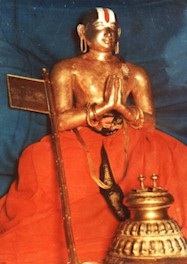
Ramanuja was placed under the Advaita (non dualism) guru, Yadava Prakasa for training in Advaita Purva Paksha Sastra of Vedanta. In many occasions Ramanuja disagreed with Yadava on the purport of the Vedanta texts. Ramanuja fearlessly pointed out the errors in his Guru's interpretations and corrected him. The enraged Yadava, fearing, Ramanuja would destroy Advaita philosophy, plotted to kill him by drowning him in river Ganges while on a pilgrimage. Learning of the plan through Govinda, another disciple who was his cousin, Ramanuja escaped by slipping out into the forest in the dark night.
During this period, Yamunacarya who wanted Ramanuja to be his successor, sent Periya Nambi to bring Ramanuja to Srirangam. However, before they could reach Srirangam, Yamuna left his material body. Ramanuja returned to Kanchipuram after promising to satisfy the three requests of Yamuna:
Later, he wrote a Granta called Nityam detailing the Tiruvaradana Kramam. Ramanuja, restored many temples rituals to the Vaisnava tradition, including Tirupati, Melkote. He was a great social reformer, and converted many irrespective of caste to Srivaisnavism. He established a list of 74 pontiffs (Simhasana Adhipathis) for the purpose of promoting and teaching Srivaisnavam. With his head on the lap of Embar and his feet on the lap of Vaduga Nambi, Ramanuja breathed his last in 1137 AD listening to the recitation of the Divya Prabandam (Dravida veda).
During this period, Yamunacarya who wanted Ramanuja to be his successor, sent Periya Nambi to bring Ramanuja to Srirangam. However, before they could reach Srirangam, Yamuna left his material body. Ramanuja returned to Kanchipuram after promising to satisfy the three requests of Yamuna:
- Compose a commentary on Upanishads, Vedanta Sutras and Bhagavad Gita
- Compose a commentary on Nammalvar's Tiruvaymozhi
- The name of Parasara, should be commemorated on the earth by giving it to a person worthy to bear it.
Later, he wrote a Granta called Nityam detailing the Tiruvaradana Kramam. Ramanuja, restored many temples rituals to the Vaisnava tradition, including Tirupati, Melkote. He was a great social reformer, and converted many irrespective of caste to Srivaisnavism. He established a list of 74 pontiffs (Simhasana Adhipathis) for the purpose of promoting and teaching Srivaisnavam. With his head on the lap of Embar and his feet on the lap of Vaduga Nambi, Ramanuja breathed his last in 1137 AD listening to the recitation of the Divya Prabandam (Dravida veda).
Three Great Post Ramanuja Teachers
Pillai Lokacarya
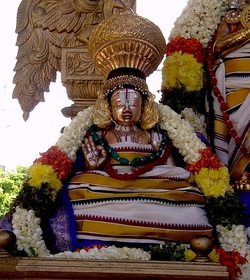
Pillai Lokacarya, 1264-1369 AD A revolutionist, he opposed all differences based upon caste, gender and taught that all should be treated equally and seek the good of all sentient beings (loka sangraha).
His revolutionary teachings were resisted by many who complained to Lord Ranganatha, that he was doing immense offence to the tradition by preaching the concepts of equality and fraternity and writing down the secret doctrines thereby negating the need to establish proper relationship between the guru and disciple.
When called upon to explain his conduct, Alagiya Manavala Perumal Nayanar appearing on behalf of his brother Pillai Lokacarya, stated that, they were merely clarifying the sacred doctrines for the benefit of those who are unable to have personal contact with the guru and for use by the future generation.
Lord Sri Ranganatha endorsed this explanation and confirmed the title Loka carya (world teacher) upon the acarya. The Lord then directed Nayanar to compile all the statements now made into a text called 'Acarya hrdayam' and that this text should be equally venerated to the works of his elder brother Pillai Loka acarya.
One of his foremost disciples was a Harijan (untouchable), called Vilancolai- pillai, who became very learned and had many Brahmins as his disciples. He was the author of a pure Tamil poem called Sapta-kathai for which Sri Manavala Mamuni later wrote a commentary.
Pllai Lokacarya wrote 18 treatises on the secret doctrines of Srivaisnavism. When the Muslims under Malik Kafur, attacked Sri Rangam, Vedanta Desikan undertook to protect the magnum opus of Sudarsana-suri -- the 'sruta prakasika'. Pillai Loka carya took upon the duty of protecting the deities. In spite of his advanced age and failing health he accompanied the temple priests who were taking the deities under cover of darkness, for safety in Tirupati. Overcome by fatigue, he rested at a crossroad and gained time for the refugees by misdirecting the pursuing Muslim soldiers. Realising that they have been misled, the soldiers returned to skin the venerable acarya alive and left him to die in agony.
His revolutionary teachings were resisted by many who complained to Lord Ranganatha, that he was doing immense offence to the tradition by preaching the concepts of equality and fraternity and writing down the secret doctrines thereby negating the need to establish proper relationship between the guru and disciple.
When called upon to explain his conduct, Alagiya Manavala Perumal Nayanar appearing on behalf of his brother Pillai Lokacarya, stated that, they were merely clarifying the sacred doctrines for the benefit of those who are unable to have personal contact with the guru and for use by the future generation.
Lord Sri Ranganatha endorsed this explanation and confirmed the title Loka carya (world teacher) upon the acarya. The Lord then directed Nayanar to compile all the statements now made into a text called 'Acarya hrdayam' and that this text should be equally venerated to the works of his elder brother Pillai Loka acarya.
One of his foremost disciples was a Harijan (untouchable), called Vilancolai- pillai, who became very learned and had many Brahmins as his disciples. He was the author of a pure Tamil poem called Sapta-kathai for which Sri Manavala Mamuni later wrote a commentary.
Pllai Lokacarya wrote 18 treatises on the secret doctrines of Srivaisnavism. When the Muslims under Malik Kafur, attacked Sri Rangam, Vedanta Desikan undertook to protect the magnum opus of Sudarsana-suri -- the 'sruta prakasika'. Pillai Loka carya took upon the duty of protecting the deities. In spite of his advanced age and failing health he accompanied the temple priests who were taking the deities under cover of darkness, for safety in Tirupati. Overcome by fatigue, he rested at a crossroad and gained time for the refugees by misdirecting the pursuing Muslim soldiers. Realising that they have been misled, the soldiers returned to skin the venerable acarya alive and left him to die in agony.
Vedanta Desikan
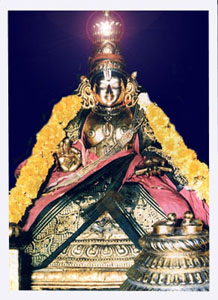
Vedanta Desikan managed to escape with the text and the two sons of Sudarsana Suri, who was slaughtered by the Muslim invaders in the temple, along with hundreds of his disciples who were with him at that time.
Vedanta Desikan, 1268-1369 AD Sri Vedanta Desikan was born in Thupul, a village near Kanchipuram, to Totaramba and Ananta Suri. Both parents came from very traditional Srivaisnava families; Ananta Suri was a Vedic Srivaisnava, belonging to the Yajur Veda, and Totaramba was the great-grand daughter of Kidambi Accan (Pranatartiharacharya), Ramanuja's cook and one of his chief disciples. Vedanta Desikan appeared on puratasi sravanam, the star of Lord Venkatesa, so accordingly his parents named him "Venkatanatha".
Vedanta Desikan's maternal uncle was the renowned scholar Kidambi Appullaar (aka Atreya Ramanuja). It was under him that Desikan studied all the scriptures. Appullaar in turn had studied Vedanta under Vatsya Varadacharya along with Sudarsana Suri (author of the Sruta-prakasika, a famous commentary on Ramanuja's Sribashya).
Tradition records that at the age of five, Desikan's precocious intelligence attracted the notice of Varadacharya, the latter blessed him and predicted that he would be a great scholar, firmly establishing the greatness of Ramanuja's philosophy. Before the age of twenty, by his own account Desikan had mastered all branches of learning, both religious and secular. In particular, he had an uncanny ability to compose poetry instantaneously combining philosophy and devotion. This combined with his expertise at the art of debate earned him the title "Kavi Tarkika Simha", or lion among poets and debaters.
A devotee of Lord Hayagriva, Desikan meditated on this form of the Lord and is said to have had a profound vision of Him. Hayagriva Stotram, Raghu Vira Gadyam, Gopala Vimsati (all in Sanskrit), Achyuta Satakam (in Prakrit), Mummanikkovai and Navamani Maalai (in Tamil) are among his works. These works are remarkable for their poetic and linguistic range, as well as their deeply emotional turns. In his Tamil love hymns to Lord Devanatha, for example, the influence of the Alvars' bhakti is transparent, as is his mastery of the Sangam Tamil conventions. The rhythmic beauty of the Raghu Vira Gadyam's prose and his touching descriptions of the Krishna-lilas in the Gopala Vimsati are among the high points of the entire gamut of India's religious literature.
At some point, Desikan returned to Kanchipuram to continue his teaching and writing. He regularly visited the many pilgrimage centres (divya desams) of this town, composing hymns on them. One of them, the Vairagya Panchakam ("Five Verses on Dispassion"), gives us a rare autobiographical insight into his personality. Addressed to Lord Varadaraja, the Vairagya Panchakam is a reply to a friend, who, upon seeing Desikan's abject poverty, invited him to join the King's court where he could lead a more comfortable life. Desikan's verses display a stern independence of spirit and utter disregard for material wealth, particularly when it distracts from the greater wealth of the company of God.
Desikan would daily go about begging for alms. This is evidenced by his declaration at the conclusion of the Vairagya Panchakam that neither he nor his father had any wealth worth speaking of, save the continuous presence of the Lord Varadaraja.
Near the end of the 13th century, it is recorded that several Advaita scholars came to Srirangam and challenged the Srivaisnavas to a debate. Being advanced in age, Sudarsana Suri invited Desika to take up the challenge. He accepted the challenge and defeated his opponents, and thereafter settled down in Srirangam. In Bhagavad Dhyana Sopanam, a contemplative poem on Lord Ranganatha, he describes Srirangam as a place where "great connoisseurs live contentedly, their minds full of delight".
When Desikan was in his thirties, his scholarly achievements in the service of God were coming at an increasing pace. He summarised his objections to Advaita in the polemic work Satadusani; he clarified many aspects of Srivaisnava ritual and practice; he constantly elucidated and clarified the philosophical teachings of his predecessors. He himself writes that he taught the entire Sri Bashya at least thirty times; the bulk of these must have occurred during his stay in Srirangam. It is also during this period that he wrote many of his "rahasya granthas", or expositions of the more esoteric doctrines of the tradition, including the nature of self-surrender (prapatti), the meaning of sacred mantras, etc. Many of these works are clearly a product of long discussions with senior scholars living in Srirangam at the time, such as Pillai Lokacarya, Alagiya Manavaala Perumal Nayanar, and Nayanar Accan Pillai. Many of the thoughts of these other acaryas are indirectly recorded in Desika's works, even when they occasionally disagree with his conclusions.
Scientific in his approach, he argues from all sides of an issue, before deriving the most logical conclusion. In examining these works one is struck by Desikan's thoroughness, and by his desire to discuss all possible meanings and nuances of an interpretation, both in the course of experience (anubhavam) as well as argument. Without Desikan's careful noting of the variety of interpretations, many important meanings would have been lost to posterity. It is no wonder that Lord Ranganatha conferred the title "Vedanta Desika" (teacher) on him.
In Srirangam that Desikan composed the Paduka Sahasram, 1008 verses on the sandals of the Lord. It is said that Desikan composed it in a single night in response to challenge from another pandit (scholar). In the course of the 32 chapters, Desikan makes countless allusions to the Alvars, to Sri Ramayanam from which the idea of the greatness of the sandals occurs, as well as other aspects of philosophy.
In 1327 Srirangam was attacked by Malik Kafur from North India, with resulting tragic consequences. In the ensuing med ham, hundreds of Srivaisnavas were killed, and the very existence of Lord Ranganatha was threatened. Led by Pillai Lokacarya, the senior most teacher at the time, with a group of Srivaisnavas hurriedly left Srirangam with the ceremonial (utsava) deity of Lord Ranganatha.
Meanwhile, the main deity of Goddess Ranganayaki was buried in the courtyard in front of Her sanctum, and Desikan is said to have supervised the building of a wall in front of the Ranganatha's sanctum hide the immovable (mulavar) deity of Rangantha in his reclining posture.
The aged Sudarsana Suri was among those who were killed during the invasion. Before his death, he entrusted his two young sons and the only manuscript of the Sruta-prakasika to Desikan's care. Desikan, the boys, and others hid themselves among the dead bodies to escape slaughter.
With the invasion Desikan left Srirangam, with his family and the sons of Sudarsana Suri and headed northwest, settling down first in Satyamangalam, (Karnataka). He then moved to Melkote, where he attracted a bright pupil, known as Brahmatantra Svatantra Jiyar, the first Swami of Sri Parakala Matham. From Melkote, Desikan proceeded to Tirupati, and then toured North Indian pilgrimage centres, like Mathura, Brindavana, Ayodhya, and Varanasi. In the course of this long exile from Srirangam, seeing the devastating destruction caused to the holiest of temples, Srirangam, he composed the Abhiti Stava, or Prayer for Freedom From Fear.
In 1360 AD, Gopanna Udaiyar defeated the Muslims, and Srivaisnavas returned to Srirangam. With the restoration of Srirangam, Desikan now returned to his service of Lord Ranganatha. Tradition records that he composed Sri Rahasya Traya Saaram, an exhaustive work on the essence of Srivaisnava philosophy, lifestyle, and the meaning of the esoteric mantras, in these last few years of his life.
In 1369, with his head resting in the lap of Kumara Varadacarya and his feet with Brahmatantra Svatantra Jiyar, Vedanta Desikan left his earthly body and ascended to the spiritual abode. He had lived the full Vedic lifespan of 100 years in an exemplary and humble manner, tirelessly engaged in the service of the Lord and Srivaisnava sampradayam. Even given such a long life, one can hardly imagine how someone can have contributed so much with so much consistency, and yet have lived such a simple life of complete poverty.
For these reasons, Vedanta Desikan is highly admired and revered by all devotees and is rightfully recognized as the greatest vaisnava teacher to have ever lived.
Vedanta Desikan, 1268-1369 AD Sri Vedanta Desikan was born in Thupul, a village near Kanchipuram, to Totaramba and Ananta Suri. Both parents came from very traditional Srivaisnava families; Ananta Suri was a Vedic Srivaisnava, belonging to the Yajur Veda, and Totaramba was the great-grand daughter of Kidambi Accan (Pranatartiharacharya), Ramanuja's cook and one of his chief disciples. Vedanta Desikan appeared on puratasi sravanam, the star of Lord Venkatesa, so accordingly his parents named him "Venkatanatha".
Vedanta Desikan's maternal uncle was the renowned scholar Kidambi Appullaar (aka Atreya Ramanuja). It was under him that Desikan studied all the scriptures. Appullaar in turn had studied Vedanta under Vatsya Varadacharya along with Sudarsana Suri (author of the Sruta-prakasika, a famous commentary on Ramanuja's Sribashya).
Tradition records that at the age of five, Desikan's precocious intelligence attracted the notice of Varadacharya, the latter blessed him and predicted that he would be a great scholar, firmly establishing the greatness of Ramanuja's philosophy. Before the age of twenty, by his own account Desikan had mastered all branches of learning, both religious and secular. In particular, he had an uncanny ability to compose poetry instantaneously combining philosophy and devotion. This combined with his expertise at the art of debate earned him the title "Kavi Tarkika Simha", or lion among poets and debaters.
A devotee of Lord Hayagriva, Desikan meditated on this form of the Lord and is said to have had a profound vision of Him. Hayagriva Stotram, Raghu Vira Gadyam, Gopala Vimsati (all in Sanskrit), Achyuta Satakam (in Prakrit), Mummanikkovai and Navamani Maalai (in Tamil) are among his works. These works are remarkable for their poetic and linguistic range, as well as their deeply emotional turns. In his Tamil love hymns to Lord Devanatha, for example, the influence of the Alvars' bhakti is transparent, as is his mastery of the Sangam Tamil conventions. The rhythmic beauty of the Raghu Vira Gadyam's prose and his touching descriptions of the Krishna-lilas in the Gopala Vimsati are among the high points of the entire gamut of India's religious literature.
At some point, Desikan returned to Kanchipuram to continue his teaching and writing. He regularly visited the many pilgrimage centres (divya desams) of this town, composing hymns on them. One of them, the Vairagya Panchakam ("Five Verses on Dispassion"), gives us a rare autobiographical insight into his personality. Addressed to Lord Varadaraja, the Vairagya Panchakam is a reply to a friend, who, upon seeing Desikan's abject poverty, invited him to join the King's court where he could lead a more comfortable life. Desikan's verses display a stern independence of spirit and utter disregard for material wealth, particularly when it distracts from the greater wealth of the company of God.
Desikan would daily go about begging for alms. This is evidenced by his declaration at the conclusion of the Vairagya Panchakam that neither he nor his father had any wealth worth speaking of, save the continuous presence of the Lord Varadaraja.
Near the end of the 13th century, it is recorded that several Advaita scholars came to Srirangam and challenged the Srivaisnavas to a debate. Being advanced in age, Sudarsana Suri invited Desika to take up the challenge. He accepted the challenge and defeated his opponents, and thereafter settled down in Srirangam. In Bhagavad Dhyana Sopanam, a contemplative poem on Lord Ranganatha, he describes Srirangam as a place where "great connoisseurs live contentedly, their minds full of delight".
When Desikan was in his thirties, his scholarly achievements in the service of God were coming at an increasing pace. He summarised his objections to Advaita in the polemic work Satadusani; he clarified many aspects of Srivaisnava ritual and practice; he constantly elucidated and clarified the philosophical teachings of his predecessors. He himself writes that he taught the entire Sri Bashya at least thirty times; the bulk of these must have occurred during his stay in Srirangam. It is also during this period that he wrote many of his "rahasya granthas", or expositions of the more esoteric doctrines of the tradition, including the nature of self-surrender (prapatti), the meaning of sacred mantras, etc. Many of these works are clearly a product of long discussions with senior scholars living in Srirangam at the time, such as Pillai Lokacarya, Alagiya Manavaala Perumal Nayanar, and Nayanar Accan Pillai. Many of the thoughts of these other acaryas are indirectly recorded in Desika's works, even when they occasionally disagree with his conclusions.
Scientific in his approach, he argues from all sides of an issue, before deriving the most logical conclusion. In examining these works one is struck by Desikan's thoroughness, and by his desire to discuss all possible meanings and nuances of an interpretation, both in the course of experience (anubhavam) as well as argument. Without Desikan's careful noting of the variety of interpretations, many important meanings would have been lost to posterity. It is no wonder that Lord Ranganatha conferred the title "Vedanta Desika" (teacher) on him.
In Srirangam that Desikan composed the Paduka Sahasram, 1008 verses on the sandals of the Lord. It is said that Desikan composed it in a single night in response to challenge from another pandit (scholar). In the course of the 32 chapters, Desikan makes countless allusions to the Alvars, to Sri Ramayanam from which the idea of the greatness of the sandals occurs, as well as other aspects of philosophy.
In 1327 Srirangam was attacked by Malik Kafur from North India, with resulting tragic consequences. In the ensuing med ham, hundreds of Srivaisnavas were killed, and the very existence of Lord Ranganatha was threatened. Led by Pillai Lokacarya, the senior most teacher at the time, with a group of Srivaisnavas hurriedly left Srirangam with the ceremonial (utsava) deity of Lord Ranganatha.
Meanwhile, the main deity of Goddess Ranganayaki was buried in the courtyard in front of Her sanctum, and Desikan is said to have supervised the building of a wall in front of the Ranganatha's sanctum hide the immovable (mulavar) deity of Rangantha in his reclining posture.
The aged Sudarsana Suri was among those who were killed during the invasion. Before his death, he entrusted his two young sons and the only manuscript of the Sruta-prakasika to Desikan's care. Desikan, the boys, and others hid themselves among the dead bodies to escape slaughter.
With the invasion Desikan left Srirangam, with his family and the sons of Sudarsana Suri and headed northwest, settling down first in Satyamangalam, (Karnataka). He then moved to Melkote, where he attracted a bright pupil, known as Brahmatantra Svatantra Jiyar, the first Swami of Sri Parakala Matham. From Melkote, Desikan proceeded to Tirupati, and then toured North Indian pilgrimage centres, like Mathura, Brindavana, Ayodhya, and Varanasi. In the course of this long exile from Srirangam, seeing the devastating destruction caused to the holiest of temples, Srirangam, he composed the Abhiti Stava, or Prayer for Freedom From Fear.
In 1360 AD, Gopanna Udaiyar defeated the Muslims, and Srivaisnavas returned to Srirangam. With the restoration of Srirangam, Desikan now returned to his service of Lord Ranganatha. Tradition records that he composed Sri Rahasya Traya Saaram, an exhaustive work on the essence of Srivaisnava philosophy, lifestyle, and the meaning of the esoteric mantras, in these last few years of his life.
In 1369, with his head resting in the lap of Kumara Varadacarya and his feet with Brahmatantra Svatantra Jiyar, Vedanta Desikan left his earthly body and ascended to the spiritual abode. He had lived the full Vedic lifespan of 100 years in an exemplary and humble manner, tirelessly engaged in the service of the Lord and Srivaisnava sampradayam. Even given such a long life, one can hardly imagine how someone can have contributed so much with so much consistency, and yet have lived such a simple life of complete poverty.
For these reasons, Vedanta Desikan is highly admired and revered by all devotees and is rightfully recognized as the greatest vaisnava teacher to have ever lived.
Manavala-mamuni
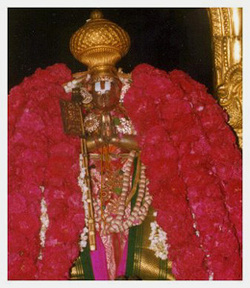
Manavala-mamuni, 1370-1443 AD Sri Manavala-mamuni was the son of Thikalakidanthan Thirunavirudayapiran Thatharannan, a disciple of Sri Pillai-lokacarya, and Sriranga Nacciyar. He was born in Kidaram (Tamilnadu) and was the first acarya to comment of the works of earlier acaryas.
His parents named him Azhakiya Manavalan (the handsome groom), after the Lord Himself. He learnt the Vedas, Vedangas and all other sastras from his father. He was an outstanding student, who knew the Dravida veda (Divya prabandhas), the Vedas and had a boundless knowledge of religion. He married at the proper time and lived as a true vaisnava. He moved to Alvar Tirunagari and became a disciple of Tiruvay-mozhip pillai.
It is said that Manavala mamuni's devotion to Nammalvar, Ramanuja and to his own Acarya grew as he studied the Alvars? hymns and doctrines (rahasyas) at Alvar Tirunagari. On observing his devotion to Ramanuja, Tiruvay-mozhip pillai ordered the construction of a Shrine for Ramanuja at Tirunagari and appointed Manavala mamuni to oversee the activities of the shrine. During this time Manavala mamuni composed his first work Yatiraja Vimsati, twenty Sanskrit stanzas in praise of Ramanuja. Tiruvay-mozhip pillai read the works and gave him the title Yatindra Pravanar.>
After the death of his guru, Tiruvay-mozhip pillai, Manavala mamuni moved to Srirangam with his family and co-disciple Ramanuja Jiyar (later known as Vanamamalai Jiyar). He was very well received at Srirangam and started to institute some reforms at the temple, very much in line with what Ramanuja did. He started to research the manuscripts of earlier acaryas and had them restored and recopied.
He went on a pilgrimage to Kanchipuram Tirupati and Sriperumpudur. While in Kanchipuram he studied Sri Bashya with Kitambi Nayanar, a disciple of Brahamatantra Svatantra Jiyar. After his return to Srirangam he renounced his householder status and took up monkhood to concentrate on temple activities. He renovated the old monastery of Ramanuja and had an icon of Pillai Lokacharya installed in Srirangam temple.
Around 1430 AD, Lord Ranganatha had all festivals stopped for a year to hear Manavala mamuni?s discourse on Nammalvar?s Tiruvaymozhi according to all the five commentaries. At the end of discourse Lord Ranganatha appeared as a young boy and placed at his feet the written verse that became to be known as Manavala mamuni's Taniyan
sri sailesa daya paatram dhi-bhaktyaqdi gunarnavam |
yatindra-pravanam vande ramya-jamatram munim ||
I pay my obeisance to the sage Manavala mamuni who is an ocean of virtues such as intelligence and devotion
and who received the mercy of his guru Sri Sailesa and is so attached to Ramanuja
By this proclamation the Lord Himself had accepted Manavala mamuni as His guru. After this incident, Manavala mamuni started writing commentaries on the works of earlier acaryas, composed independent works and compiled source documentation and cross-referencing on some important works.
He composed the commentary on Acarya Hrdayam with great difficulty as his health was failing. When he became very ill and unable to worship at the temple, he dedicated one Tamil stanza a day, expressing to Ramanuja his anguish at staying in this world and his eagerness to reach Vaikuntha. These collected verses became known as Arti Prabhantham, his last work.
Manavala mamuni had many disciples, however, the following eight were the chief disciples known as Ashtadiggajas (elephants of the eight directions):
His parents named him Azhakiya Manavalan (the handsome groom), after the Lord Himself. He learnt the Vedas, Vedangas and all other sastras from his father. He was an outstanding student, who knew the Dravida veda (Divya prabandhas), the Vedas and had a boundless knowledge of religion. He married at the proper time and lived as a true vaisnava. He moved to Alvar Tirunagari and became a disciple of Tiruvay-mozhip pillai.
It is said that Manavala mamuni's devotion to Nammalvar, Ramanuja and to his own Acarya grew as he studied the Alvars? hymns and doctrines (rahasyas) at Alvar Tirunagari. On observing his devotion to Ramanuja, Tiruvay-mozhip pillai ordered the construction of a Shrine for Ramanuja at Tirunagari and appointed Manavala mamuni to oversee the activities of the shrine. During this time Manavala mamuni composed his first work Yatiraja Vimsati, twenty Sanskrit stanzas in praise of Ramanuja. Tiruvay-mozhip pillai read the works and gave him the title Yatindra Pravanar.>
After the death of his guru, Tiruvay-mozhip pillai, Manavala mamuni moved to Srirangam with his family and co-disciple Ramanuja Jiyar (later known as Vanamamalai Jiyar). He was very well received at Srirangam and started to institute some reforms at the temple, very much in line with what Ramanuja did. He started to research the manuscripts of earlier acaryas and had them restored and recopied.
He went on a pilgrimage to Kanchipuram Tirupati and Sriperumpudur. While in Kanchipuram he studied Sri Bashya with Kitambi Nayanar, a disciple of Brahamatantra Svatantra Jiyar. After his return to Srirangam he renounced his householder status and took up monkhood to concentrate on temple activities. He renovated the old monastery of Ramanuja and had an icon of Pillai Lokacharya installed in Srirangam temple.
Around 1430 AD, Lord Ranganatha had all festivals stopped for a year to hear Manavala mamuni?s discourse on Nammalvar?s Tiruvaymozhi according to all the five commentaries. At the end of discourse Lord Ranganatha appeared as a young boy and placed at his feet the written verse that became to be known as Manavala mamuni's Taniyan
sri sailesa daya paatram dhi-bhaktyaqdi gunarnavam |
yatindra-pravanam vande ramya-jamatram munim ||
I pay my obeisance to the sage Manavala mamuni who is an ocean of virtues such as intelligence and devotion
and who received the mercy of his guru Sri Sailesa and is so attached to Ramanuja
By this proclamation the Lord Himself had accepted Manavala mamuni as His guru. After this incident, Manavala mamuni started writing commentaries on the works of earlier acaryas, composed independent works and compiled source documentation and cross-referencing on some important works.
He composed the commentary on Acarya Hrdayam with great difficulty as his health was failing. When he became very ill and unable to worship at the temple, he dedicated one Tamil stanza a day, expressing to Ramanuja his anguish at staying in this world and his eagerness to reach Vaikuntha. These collected verses became known as Arti Prabhantham, his last work.
Manavala mamuni had many disciples, however, the following eight were the chief disciples known as Ashtadiggajas (elephants of the eight directions):
- Vanamamalai Jiyar,
- Bhattar Piraan jiyar,
- Tiruvengada jiyar,
- Koil kanthaadai annan,
- Prathivaadhi Bhayankaram annaa,
- Erumbi appaa,
- Appillai,
- Appillan.
Sri Perumbudur,
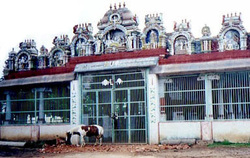
Sri Perumbudur, Sthala Purana Sri Perumpudur, formerly known as Bhuta-puri, is the birthplace of Sri Ramanuja. In the Skanda Purana the mythological history of this holy place is narrated by Lord Skanda to sage Agastiya.
Once the sages residing in Naimi-saranya, approached Suta, (a disciple of Veda Vyasa) to learn about the Lord Vishnu's holy ksethras (places where Lord Vishnu had His pastimes). Suta narrated the history of Bhuta-puri (Sri Perumpudur) to the sages, as how it was original imparted by Lord Skanda to Agastiya.
Birthplace of Sri Ramanuja
Chidldless, Yuvanasava, the son of King Ambarisa performed a fire sacrifice to beget a child. During the sacrifice, the mantra for begetting a brahmana child was accidentally chanted. After the child was born, he was named Haridan, who grew up to marry the daughter of the King of Kasi (Varanasi). Once while hunting, King Haridan saw a tiger about to attack a cow, to protect the cow, King Haridan shot his arrow at the tiger. Wounded, the tiger ferociously attacked and killed the cow.
Holding himself responsive for the death of the cow, King Haridan was very upset. At that oracle said "Do not worry, go to Bhuta-puri, bath in the Ananda-saras tirta and worship Lord Adi Kesava, all your sins will be vanquished". King Haridan, then approached his guru Vasistha, who initiated him and narrated the greatness of Bhuta-puri.
Once Lord Shiva was dancing nude in the assembly of the bhutas (troll-like attendants).This amused the bhutas (trolls) who burst into laughter. Angered by their behaviour, Lord Shiva cursed them to lose the association of His abode. The disheartened bhutas approached Brahma and narrated their plight.
Brahma advised them, "Listen, O Bhutas! In Jambuvipa's Barata-varsa exists a holy ground south of Tirumala, known as Satya-vrata kshestra. Moving north east from Satyavrata, is Aruna-ranyam a forest, spend time there and meditate on Lord Vishnu and be redeemed of Lord Shiva's wrath".
As instructed, the bhutas arrived in Aruna-ranyam and spent a thousand years in meditation of Lord Vishnu. Touched by their determination, the Lord appeared and blessed them. He then granted the bhutas their wish to be with Lord Shiva and requested His serpentine couch Adisesha to build a large pond .The Bhutas took a dip in the pond to cleanse themselves before approaching Lord Shiva.
Lord Shiva appeared in Aruna-ranyam at the request of Lord Vishnu. He accepted the Bhutas back to His abode. The Bhutas with the blessings of Lord Shiva, then built the temple city for worshipping Lord Vishnu in his Adi Kesava deity form.
Once the sages residing in Naimi-saranya, approached Suta, (a disciple of Veda Vyasa) to learn about the Lord Vishnu's holy ksethras (places where Lord Vishnu had His pastimes). Suta narrated the history of Bhuta-puri (Sri Perumpudur) to the sages, as how it was original imparted by Lord Skanda to Agastiya.
Birthplace of Sri Ramanuja
Chidldless, Yuvanasava, the son of King Ambarisa performed a fire sacrifice to beget a child. During the sacrifice, the mantra for begetting a brahmana child was accidentally chanted. After the child was born, he was named Haridan, who grew up to marry the daughter of the King of Kasi (Varanasi). Once while hunting, King Haridan saw a tiger about to attack a cow, to protect the cow, King Haridan shot his arrow at the tiger. Wounded, the tiger ferociously attacked and killed the cow.
Holding himself responsive for the death of the cow, King Haridan was very upset. At that oracle said "Do not worry, go to Bhuta-puri, bath in the Ananda-saras tirta and worship Lord Adi Kesava, all your sins will be vanquished". King Haridan, then approached his guru Vasistha, who initiated him and narrated the greatness of Bhuta-puri.
Once Lord Shiva was dancing nude in the assembly of the bhutas (troll-like attendants).This amused the bhutas (trolls) who burst into laughter. Angered by their behaviour, Lord Shiva cursed them to lose the association of His abode. The disheartened bhutas approached Brahma and narrated their plight.
Brahma advised them, "Listen, O Bhutas! In Jambuvipa's Barata-varsa exists a holy ground south of Tirumala, known as Satya-vrata kshestra. Moving north east from Satyavrata, is Aruna-ranyam a forest, spend time there and meditate on Lord Vishnu and be redeemed of Lord Shiva's wrath".
As instructed, the bhutas arrived in Aruna-ranyam and spent a thousand years in meditation of Lord Vishnu. Touched by their determination, the Lord appeared and blessed them. He then granted the bhutas their wish to be with Lord Shiva and requested His serpentine couch Adisesha to build a large pond .The Bhutas took a dip in the pond to cleanse themselves before approaching Lord Shiva.
Lord Shiva appeared in Aruna-ranyam at the request of Lord Vishnu. He accepted the Bhutas back to His abode. The Bhutas with the blessings of Lord Shiva, then built the temple city for worshipping Lord Vishnu in his Adi Kesava deity form.
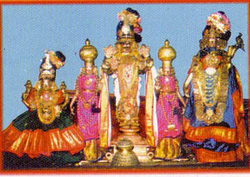
Lord Adi Kesava and his consorts, the presiding deities of Sri Perumbudur
The devas (gods), kings, vedic priest and sages arranged a festival for Lord Adi Kesava. A grand ceremony of bathing the Lord in the pond was conducted as part of the festival. Lord Shiva then requested Lord Adi Kesava to eternally reside in Bhuta-puri. He promised to come annually and worship Lord Adi Kesava during the festival. As the Bhutas constructed the city, it was called Bhuta-puri.
In later years Bhuta-puri became neglected. In his attempt to redeem himself from the sin of killing the cow, Haridan visited Bhuta-puri and spent years in severe austerities and meditation. Lord Vishnu with His consort Laksmi, mounting on Garuda appeared before Haridan. The Lord freed Haridan from his sin and blessed him to acquire brahminical (priestly) qualities. The Lord instructed Haridan, to re-develop Bhuta-puri with splendid buildings and towers and continue the festivals. After executing his services to Lord Adi Kesava, Haridan return to the Lord's abode. Till today, the descendents of Haridan worship and render their devotional services to Lord Adi Kesava.
The devas (gods), kings, vedic priest and sages arranged a festival for Lord Adi Kesava. A grand ceremony of bathing the Lord in the pond was conducted as part of the festival. Lord Shiva then requested Lord Adi Kesava to eternally reside in Bhuta-puri. He promised to come annually and worship Lord Adi Kesava during the festival. As the Bhutas constructed the city, it was called Bhuta-puri.
In later years Bhuta-puri became neglected. In his attempt to redeem himself from the sin of killing the cow, Haridan visited Bhuta-puri and spent years in severe austerities and meditation. Lord Vishnu with His consort Laksmi, mounting on Garuda appeared before Haridan. The Lord freed Haridan from his sin and blessed him to acquire brahminical (priestly) qualities. The Lord instructed Haridan, to re-develop Bhuta-puri with splendid buildings and towers and continue the festivals. After executing his services to Lord Adi Kesava, Haridan return to the Lord's abode. Till today, the descendents of Haridan worship and render their devotional services to Lord Adi Kesava.
